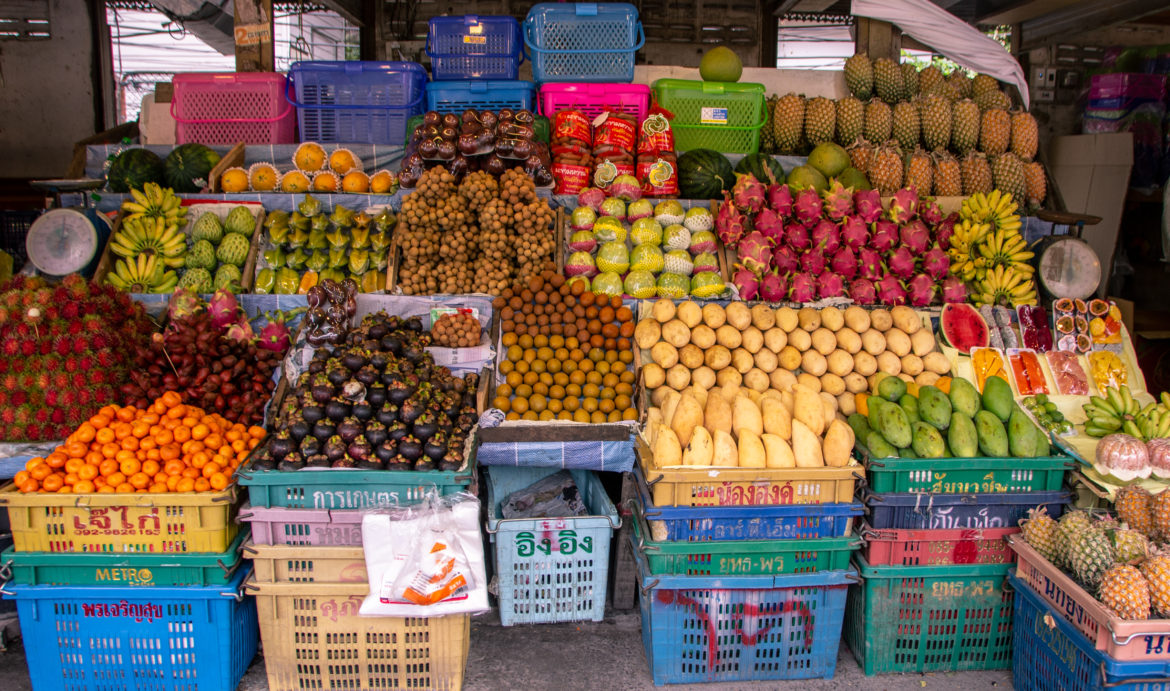The delicious and healthy fruit of Southeast Asia is one of the best things about travelling in this region. The Asian markets provide a healthy odyssey for travelling foodies. The fruits with protective rinds are a safe way to explore the market produce in third world countries. When in SE Asia, I began to slim down and crave fruits from the hot weather. In Ho Chi Minh City (Saigon), I had an epiphany about the awesomeness of the colorful fruits, inspiring me to explore the southeast Asian fruits health benefits.

SE Asian Fruits Health Benefits
Eat & Travel Well
Soapberry Family – Longan, Lychee & Rambutan
The 3 most well-known fruits from the soapberry family fruits are longan, lychee and rambutan. Longan fruit comes from a tropical tree, with a Cantonese name meaning “Dragon’s Eye.” Its black seed with white, translucent flesh around it, looks like an eyeball and pupil. Longan has vitamin A and C, magnesium and iron; plus, it is anti-fungal, anti-viral and anti-bacterial. Chinese Medicine Food Therapy uses it for anxiety, insomnia, rapid heart rate and forgetfulness.

Lychee means “leaving the branch,” because it’s inedible within 4 days off the tree. It has a jelly-like texture and is very juicy. Along with providing Vitamin C and B6, lychee’s health benefits improve a weak digestive system, poor appetite or memory, and insomnia. According to Traditional Chinese Medicine (TCM), lychee’s properties are warm and should be eaten in moderation or can cause problems, such as, ulcers, acne or sore throat.
Rambutan is the largest of the 3, about the size of a golf ball with a creamy flesh that is slightly floral and a seed that is toxic. It’s an antioxidant powerhouse with Vitamin C, iron, and phosphorous. Its health benefits strengthen digestion and antiseptic properties to fight infections and kill intestinal parasites.

Mangosteen and Durian
Durian and Mangosteen are the yin and yang of fruits in southern Asia, touted as the “King and Queen of Fruits,” respectively. The Durian also called jack fruit, has a pungent odor that is offensive to many, smelling like a dirty sock or garbage. However, its taste makes up for the smell, with a unique blend of surprising flavors like almond, chocolate and custard.
Its phytonutrients include Vitamin C, B-6, potassium and protein, with health benefits that offer better energy, digestion, and libido. Yes, durian is an aphrodisiac and increases fertility for both males and females. Due to its warming properties, Durian should be eaten in moderation. If consumed too much, mung beans or mangosteen counterbalance, with their cooling properties.

The purple mangosteen, known as the “Queen of Fruits” has a thick purple rind with white flesh that is sweet and tangy. The fruit teases, as it’s scanty yet so tasty, being able to eat 3-4 at once as I do. Mangosteen is abundant with antioxidants and xanthones. It has many health benefits, such as, anti-inflammatory, anti-cancer, ant-microbial, increase immunity, inhibits cell growth in colon cancer, used with anti-cancer drugs, diarrhea, UTI’s, and dysentery. Also, skincare products use it to help inflammation, aging, allergies, and eczema.

Dragon and Star Fruit
The Dragon and Star Fruit both get their names from their appearances. The dragon fruit or white-fleshed pitahaya is a species of cactaceae and native to Central America. The French brought it to Vietnam where it thrives in this climate. The rind is bright, fuchsia pink with thick layers like a dragon’s scales with white fruit inside and many small, edible black seeds.
Dragon fruit has many antioxidants, vitamin C, protein, calcium and the phytochemical, captin, enabling it to be therapeutic for heart problems. According to TCM, its fruit (white, the color corresponding with the lungs) moistens the lungs, eliminates toxic heat and is good for a dry cough. The star fruit is shaped like a 5-point star and is yellow or green. It is also known as Carambola or 5 Fingers and the entire fruit is edible.

The larger ones are a sweet flavor, and the smaller ones are sour. Starfruit’s phytonutrients include vitamin C, fiber, antioxidants, and quercetin (good for allergies). It also prevents fat cell formation, decreasing a fatty liver, cholesterol and inflammation. For those with kidney problems or taking prescription drugs, they should consult their doctor before eating starfruit. It contains oxalates, similar to grapefruits, that can alter how drugs are metabolized.

Cheerimoya or Custard Apple
The last fruit described here is my favorite with many names and species around the world. It’s known as Custard Apple, Sweet Sop, Buddha’s Head and Cherimoya. It can be very filling with its high fiber content of creamy, white fruit that has an exquisite custard-like taste and is good for digestion. With its high content of Vitamin C and riboflavin, it benefits poor vision, night blindness and macular degeneration.
Enjoy Asian Fruits Health Benefits!
There are many other fruits in southeast Asia, however, I mostly focused on ones that are native to this region. There are also luscious pineapples, oranges, coconut, guavas, bananas, apples, mangoes, watermelons (yellow and red) and papayas. Mother Nature offers these wonderful gifts, abundant with phytonutrients to support our health and wellness. Especially, when travelling we can use a boost in nutrition, hydration and immunity to balance the travails of travel. Bon Appetit and enjoy the healthy fruit odyssey when exploring southeast Asia.
Read Next!
Fish Spa’s Health Benefits & Risks, Plus Why I Won’t Do Them Again
Mysterious Ha Long Bay, Vietnam Junk Boat Cruise


